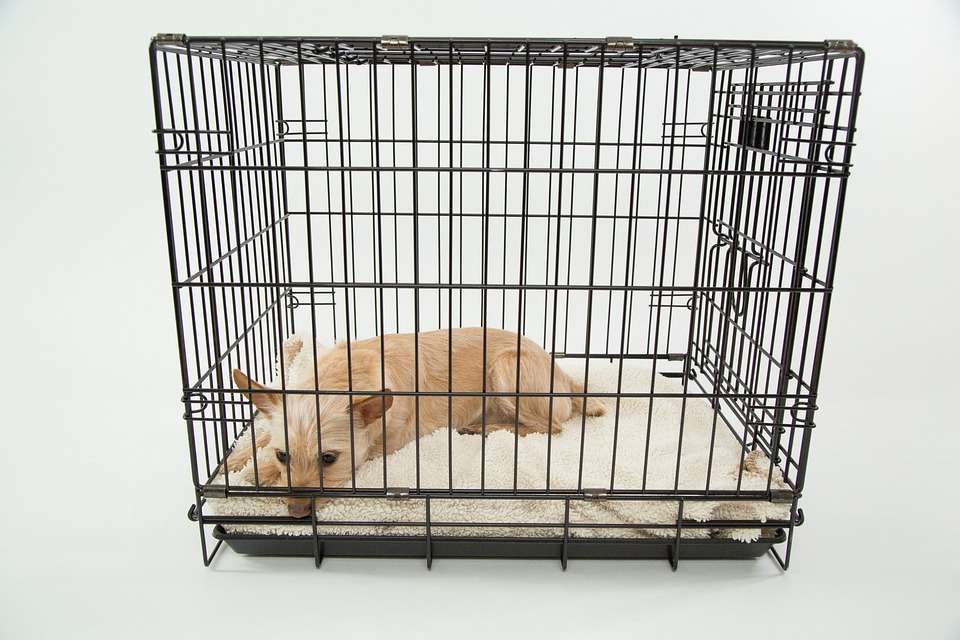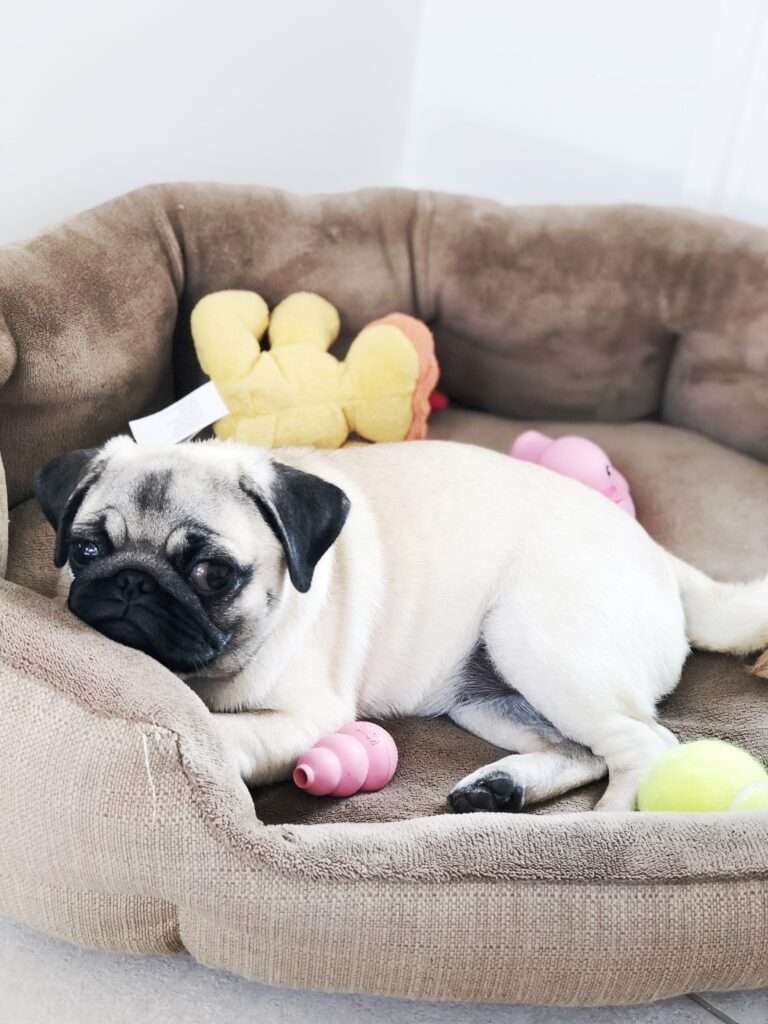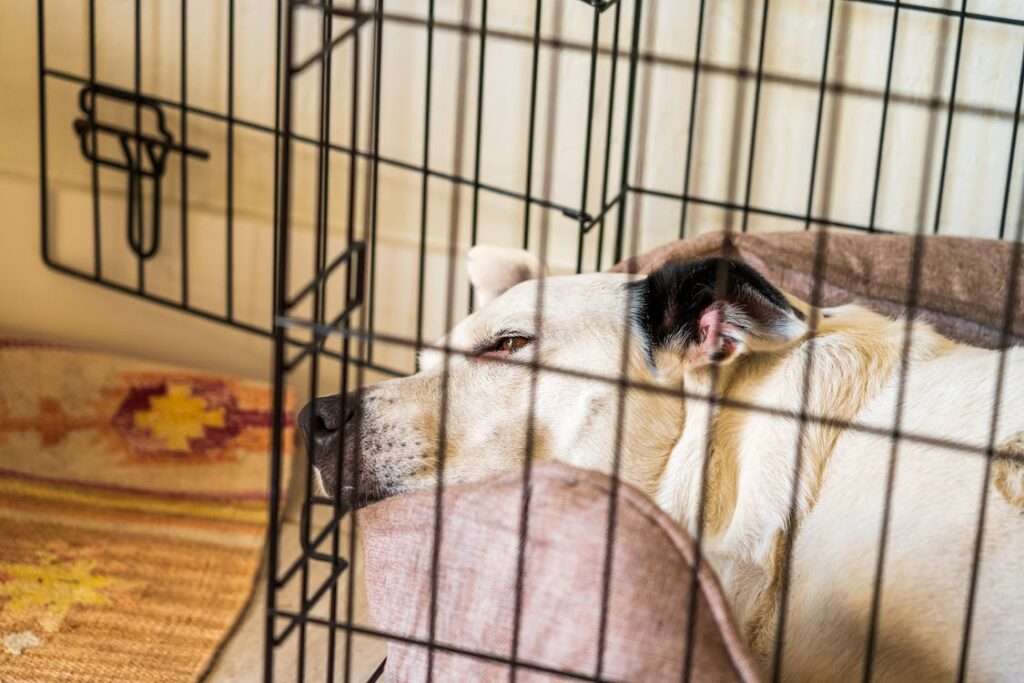Until What Age Should a Dog Sleep in a Crate? An Expert’s Guide
As pet owners, we all want our furry friends to feel comfortable and secure in our homes. One way to achieve this is through crate training. Crate training has numerous benefits for both puppies and adult dogs, including providing a safe space, aiding in potty training, reducing destructive behavior, easing anxiety, and making traveling with your dog easier.
At BarkLikeMeow, we understand that crate training can be a controversial topic among pet owners. That’s precisely why we’ve developed a comprehensive guide to help you make an informed decision about when it’s suitable for your dog to discontinue sleeping in a crate.
Benefits of Crate Training for Dogs

When it comes to crate training, it’s important to start early. The younger your dog is when they are introduced to the crate, the easier it will be for them to adapt. However, it’s never too late to start crate training, and older dogs can benefit from it too.
When deciding when to start crate training your dog, there are a few factors to consider. Primarily, it’s essential to consider your dog’s personality and temperament. Some dogs may take to the crate right away, while others may need more time and patience. Additionally, it’s important to choose the right size crate for your dog and to make the crate a comfortable and inviting space.
If you’re unsure about when to start crate training or how to introduce your dog to the crate, don’t hesitate to consult with a professional dog trainer or veterinarian. With the right approach, crate training can be a positive and rewarding experience for both you and your furry friend.
When to Start Crate Training Your Dog
Once your dog is comfortable with the crate, the next question that arises is how long they should sleep in it. The appropriate crate time will depend on a variety of factors, including your dog’s age, size, and activity level.
For puppies, crate time should be limited to avoid accidents and ensure that they get the proper amount of exercise and socialization. As your puppy grows older, you can gradually increase their crate time.
Adult dogs typically need less crate time, but it’s still important to provide them with a safe and comfortable space to retreat to when needed. Senior dogs may require more frequent breaks outside of the crate to stretch and move around.
It’s worth emphasizing that the crate should never be employed as a means of punishment, and it’s vital to avoid leaving your dog alone in the crate for prolonged periods of time. As a rule of thumb, it’s advisable not to keep dogs confined in a crate for longer than four to six hours at a time.
How Long Should Your Dog Sleep in a Crate
So, how do you know when your dog is ready to sleep outside of the crate? There are a few signs to look out for, including improved behavior and reduced anxiety when outside of the crate, as well as a lack of accidents and destructive behavior.
To test if your dog is ready to sleep outside of the crate, you can gradually increase the amount of time they spend outside of the crate while closely monitoring their behavior. You can also try leaving them alone in a room without the crate for short periods of time.
If your dog shows signs of anxiety or begins exhibiting destructive behavior, it may be too soon to transition them out of the crate. However, with patience and consistency, most dogs can successfully make the transition to sleeping outside of the crate.
Remember, crate training should always be a positive and rewarding experience for your dog. With the right approach and plenty of patience, you can help your furry friend feel safe and secure in your home.
Signs Your Dog is Ready to Sleep Outside of a Crate
While every dog is different, there are a few signs that can indicate your pup is ready to sleep outside of their crate. Here are a few things to look out for:
- Improved behavior: If your dog is exhibiting good behavior outside of their crate and is not destroying anything or having accidents, this may be a sign they are ready to transition.
- Reduced anxiety: If your dog seems more relaxed and less anxious when outside of their crate, this could be an indication that they are ready to spend more time outside of it.
- No accidents: If your dog is consistently going to the bathroom outside and not having accidents in the house, this may be a sign they can handle being outside of their crate at night.
- Age: Older dogs may not need as much crate time as puppies, so if your dog is an adult or senior and is comfortable outside of their crate, they may be ready to transition.
It’s important to bear in mind that each dog is unique, and when it comes to transitioning your dog out of their crate, taking things slowly and exercising patience is crucial.
Alternatives to Crate Training

While crate training can be an effective way to provide your dog with a safe and comfortable space, it’s not the only option. Here are a few alternatives to consider:
- Dog beds: Providing your dog with a comfortable bed or mat to sleep on can be a great alternative to crate training. Make sure to choose a bed that is appropriate for your dog’s size and sleeping preferences.
- Playpens: If you want to provide your dog with a designated space to play and relax, a playpen may be a good option. Playpens can be used indoors or outdoors and can be customized to fit your dog’s needs.
- Baby gates: Baby gates can be used to block off certain areas of your home, providing your dog with a safe and secure space without the need for a crate.
- Dog-proofing: If your dog is well-behaved and doesn’t have any destructive tendencies, you may be able to forgo the crate altogether by dog-proofing your home and providing your pup with plenty of toys and stimulation.
Ultimately, the best option for your dog will depend on their individual needs and personality. By considering all of your options and consulting with a professional if necessary, you can find the best way to provide your furry friend with a safe and comfortable space to sleep.
How to Make Crate Training a Positive Experience for Your Dog
Crate training can be a positive experience for your dog if done correctly. Here are a few tips to ensure your pup has a good experience:
- Start slow: Begin by introducing your dog to the crate and allowing them to explore it on their own terms. Gradually introduce them to spending short amounts of time in the crate with the door closed.
- Provide comfort: Make sure your dog has a comfortable bed or blanket to sleep on in the crate. You can also provide toys and treats to help them associate the crate with positive experiences.
- Use positive reinforcement: Reward your dog with treats and praise when they enter and exit the crate willingly. This will help them associate the crate with positive experiences.
- Be patient: Crate training takes time and patience. Don’t rush the process and be prepared for setbacks along the way.
Common Mistakes to Avoid When Crate Training Your Dog

While crate training can be a positive experience for your dog, there are a few common mistakes to avoid:
- Using the crate as punishment: Never use the crate as a form of punishment. This will create negative associations with the crate and make it more difficult to crate train your dog.
- Leaving your dog in the crate for too long: Dogs should not be crated for longer than four to six hours at a time. Leaving your dog in the crate for extended periods of time can lead to anxiety and discomfort.
- Choosing the wrong size crate: Make sure to choose a crate that is appropriate for your dog’s size. A crate that is too small can be uncomfortable, while a crate that is too large can lead to accidents.
- Neglecting your dog’s needs: Make sure to provide your dog with plenty of exercise, socialization, and attention outside of the crate. Neglecting your dog’s needs can lead to anxiety and behavioral issues.
By avoiding these common mistakes and following the tips outlined above, you can make crate training a positive experience for your furry friend. Remember to be patient, consistent, and always provide your dog with plenty of love and attention.
Conclusion
Crate training can be a helpful tool for providing your dog with a safe and comfortable space to sleep and relax. However, it’s important to take things slow and be patient when introducing your dog to the crate. By using positive reinforcement and providing comfort and security, you can help your dog learn to love their crate.
Keep in mind that every dog is unique and there is no single approach that works for all when it comes to crate training. Therefore, it’s important to seek guidance from a professional trainer or veterinarian if you have any concerns or questions regarding the best approach to crate training for your furry friend.
In the end, the top priority is to give your dog a secure and affectionate home where they feel content and at ease. By taking the time to comprehend your dog’s requirements and equipping them with appropriate tools and resources, you can create a joyous and healthy life for both you and your four-legged companion.
Frequently Asked Questions
What is crate training?
Crate training is a process where a dog is trained to become comfortable with and eventually enjoy spending time in a crate or kennel. This can be a useful tool for house training, providing a safe space for the dog, and traveling with the dog.
Can a dog be crate-trained at any age?
Yes, a dog can be crate-trained at any age. However, it may take longer for an older dog to become comfortable with spending time in a crate, especially if they have not been crate-trained before.
Is crate training cruel?
Crate training is not cruel when done properly. It can provide a safe and comfortable space for a dog and can be a useful tool for house training and traveling. However, it is important to never use the crate as a form of punishment and to ensure that the dog has plenty of exercise and socialization outside of the crate.
How do I crate train my dog?
Crate training involves gradually introducing your dog to the crate and making it a positive and comfortable space for them. This can be done by placing treats and toys in the crate, feeding the dog in the crate, and gradually increasing the amount of time the dog spends in the crate.
Should I leave my dog in a crate while I’m at work?
It’s generally not recommended to leave a dog in a crate for extended periods of time, such as while you’re at work. If you need to crate your dog while you’re away, it’s important to ensure that they have plenty of exercise, mental stimulation, and socialization outside of the crate.
Can I use a crate for a puppy?
Yes, a crate can be a useful tool for house training a puppy and keeping them safe while you’re away. However, it’s important to ensure that the crate is the appropriate size for the puppy and that they are not left in the crate for too long.
What if my dog doesn’t like the crate?
If your dog doesn’t like the crate, it’s important to take things slow and gradually introduce them to the crate in a positive and comfortable way. You can try placing treats and toys in the crate, feeding the dog in the crate, and gradually increasing the amount of time the dog spends in the crate. If your dog continues to be fearful or anxious in the crate, it may be best to seek the help of a professional dog trainer.
How long should a dog be crated?
As a rule of thumb, it’s advisable not to keep dogs confined in a crate for longer than four to six hours at a time. However, the exact amount of time a dog can spend in a crate depends on the dog’s age, temperament, and physical needs.
Until what age should a dog sleep in a crate?
There is no single right age to permit your dog to sleep in a different bed. Instead, there is a suggested training protocol you can try out, adjusting as you go. Depending on your preference and the individual dog, dogs can be crated at night until around the age of 2 years old. Around that age is when they are usually fully potty trained and less likely to get into things as long as they have had plenty of exercise.
Can I use a crate for multiple dogs?
Yes, a crate can be used for multiple dogs as long as there is enough space for each dog to be comfortable and the dogs get along well. It’s important to supervise the dogs while they are in the crate together and to ensure that they each have their own food and water bowls.
References
- “Until What Age Should A Dog Sleep In A Crate? – The Labrador Site.” The Labrador Site, https://www.thelabradorsite.com/until-what-age-should-a-dog-sleep-in-a-crate/.
- “Until What Age Should a Dog Sleep in a Crate? (Trainer Explains).” Not A Bully, https://notabully.org/until-what-age-should-a-dog-sleep-in-a-crate/.
- Hill, Jenny. “Crate Sleeping Basics.” The Fresno Bee, 1 Sept. 2023, https://www.fresnobee.com/reviews/dog-crate-sleeping-basics/.
- “When Should Your Dog Stop Sleeping In A Crate?” Breed Advisor, https://breedadvisor.com/when-should-your-dog-stop-sleeping-in-a-crate/.




